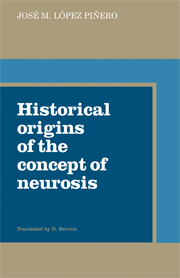4 - The physiopathological view and the concept of neurosis
Published online by Cambridge University Press: 06 August 2010
Summary
The physiopathological view, the other dominant trend in nineteenth-century scientificonatural medicine, developed as a modification of the anatomoclinical view which must be considered as the very foundation of the new medicine. Its novelty was to emphasize the ‘functional’, which had been neglected by the great French writers and their followers, and to study objectively clinical and pathological dysfunctions. Laín Entralgo has carried out a masterly study of the group of German authors (Wunderlich, Griesinger, Frerichs and Traube) who occupied themselves with the notion of dysfunction. They presided over the modification of the anatomoclinical view under the influence of dynamic and idealist views received from an earlier period of German medicine. The dynamic processes of old, rid of all speculative elements, adapted themselves to the new view: Naturphilosophie became Naturwissenschaft.
The preponderance of the German school should not conceal the fact that the French and the British also sponsored the physiopathological view. In the Paris of the early nineteenth century the only view that kept the notion of the ‘functional’ alive was the ‘heterodox’ doctrine of Broussais. The so-called ‘Physiological medicine’, although occasionally exaggerated, showed a commendable insistence on physiopathology. Its early demise did not prevent ‘Médecine physiologique’ from influencing both the orthodox French anatomoclinical view and the British physiopathological school. However the main origin of the latter must still be sought in the influential views of John Hunter who interested himself both in the experimental analysis of function and in its post-mortem concomitants.
- Type
- Chapter
- Information
- Historical Origins of the Concept of Neurosis , pp. 59 - 76Publisher: Cambridge University PressPrint publication year: 1983



